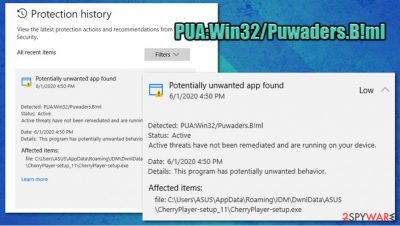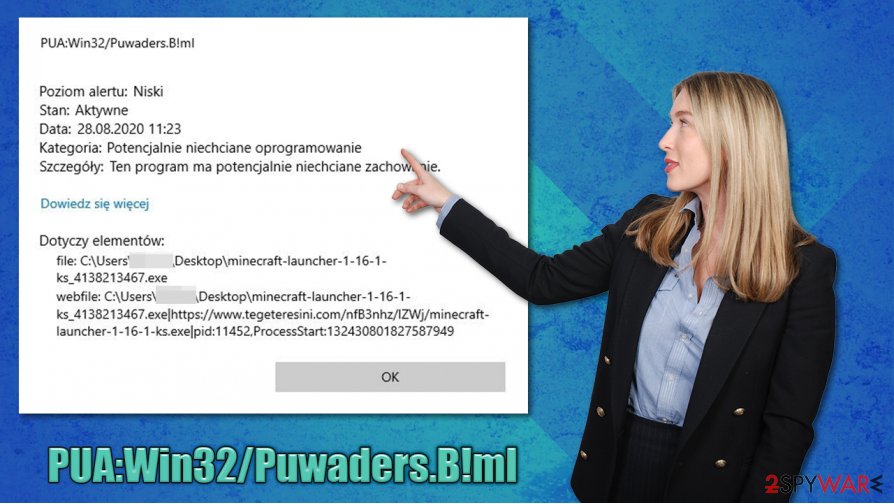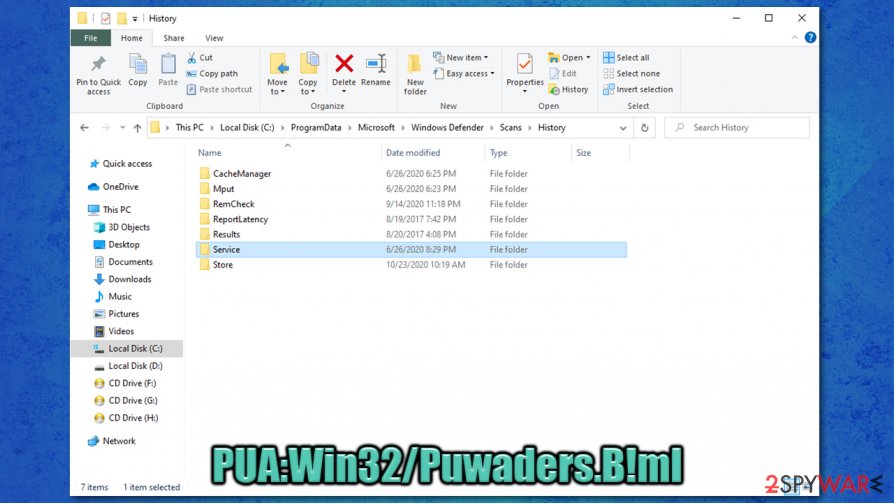PUA:Win32/Puwaders.B!ml (Removal Instructions) - Free Guide
PUA:Win32/Puwaders.B!ml Removal Guide
What is PUA:Win32/Puwaders.B!ml?
PUA:Win32/Puwaders.B!ml – a detection name for adware app that is hard to get rid of

PUA:Win32/Puwaders.B!ml is a Windows Defender-assigned name for an adware application that has infiltrated your computer. It is based on heuristic analysis, which means that security software detected the potentially unwanted program based on the way it functions rather than its name. As a result, there could be many different apps that are hiding behind the PUA:Win32/Puwaders.B!ml virus name.
Adware, which is also known as ad-supported software, is a minor computer threat that typically arrives on the system without asking for direct permission, as developers use fake updates or software bundles to distribute it. Once installed, the app would change certain browser settings (in some cases, system file modification can occur as well) in order to deliver users popups, banners, deals, coupons, offers, and other commercial content, regardless if Google Chrome, Mozilla Firefox, or MS Edge is used.
If you are looking for the PUA:Win32/Puwaders.B!ml removal solutions because the threat seems to be coming back, we will explain why this happens and ways on how to get rid of this annoying infection once and for all.
| Name | PUA:Win32/Puwaders.B!ml |
|---|---|
| Type | Adware, potentially unwanted program |
| Distribution | Software bundles, third-party websites, deceptive ads, fake Flash Player updates |
| Symptoms | Windows Defender detects a potentially unwanted program repeatedly; potential browser settings changes; increased number of ads and redirects to unsafe sites |
| Dangers | Installation of other potentially unwanted programs or malware, monetary losses, sensitive information disclosure to unknown parties |
| Elimination | We recommend attempting to delete the PUP manually as per instructions below. If security software keeps detecting the same threat again, you need to delete Windows Defender history – check instructions below. Additionally, you should scan your computer with an alternative security tool, such as SpyHunter 5Combo Cleaner |
| Further steps | Malware or adware infections can diminish the performance of your computer or cause serious stability issues. Use FortectIntego to remediate your device and ensure that the virus damage is fixed |
Adware is usually not considered a dangerous piece of software, although some examples show the complete opposite. In most cases, the adware will hijack web browsers and inject advertisements into them, all while spying on users' web browsing activities in the background. Programs like PUA:Win32/Puwaders.B!ml typically have limited or no useful functionality and are not desired by most users.
In this particular case, the so-called PUA:Win32/Puwaders.B!ml virus might change your homepage without permission, redirect all your searches to another provider (such as Yahoo or Bing), install unwanted browser extensions, and drops its files all over the system. Certain modifications within the Windows registry can later cause problems with the computer's stability, so we recommend using FortectIntego after the threat is eliminated.
There is no doubt that you should not hesitate to remove PUA:Win32/Puwaders.B!ml from your machine as soon as possible, as it can not only diminish web browsing experience but also put your online privacy and security at risk (some links and redirects might bring you to malicious websites).
Unfortunately, most of the users who had Windows Defender detect this threat were unable to remove PUA:Win32/Puwaders.B!ml from their system as they would with any other detection. Even after their cleared web browsers cookies, web data and uninstalled the app in question, it would still return the next time the security software would perform a scan.
The truth is that repeated detection of the virus is caused by a bug within Windows Defender running on Windows versions 2004. Since the release of this OS version, Windows began flagging potentially unwanted programs as malicious, and many users complained that they are unable to remove many of such detections.
To get rid of the repeated detection, you should delete Protection History within Windows Defender. For more details, check the removal section below.

Potentially unwanted program prevention tips
In most cases, users find potentially unwanted programs installed on their systems without permission and tend to believe that they simply self-installed. However, adware does not possess such functionality, as these programs are relatively simple, and users install PUPs themselves (without the intention of doing so). It does not change the fact that the developers of freeware and sites that distribute them often to engage in deceptive practices in order to spread the software around the world.
There two main methods of how adware and other unwanted programs are distributed – software bundling and deceptive ads/fake updates. Security experts recommend the following to avoid unwanted infiltration of potentially dangerous software:
- If possible, download apps from official sources only;
- Never attempt to download pirated programs or software cracks;
- When visiting third-party sites, keep in mind that optional apps are likely to insert into the installer of your desired program;
- When you launch the installation wizard, do not rush the steps, and read the instructions carefully;
- When prompted, always pick Advanced/Custom settings instead of Recommended/Quick ones;
- Remove all ticks from pre-ticked checkboxes;
- Always read the fine print;
- Decline all the offers and watch out for misleading button placements (“Skip offer” is often placed on the right side of the pop-up window, resulting in the unintentional installation of PUPs);
- Install reliable security software that can warn you about unwanted programs.
The correct way to remove PUA:Win32/Puwaders.B!ml virus
PUA:Win32/Puwaders.B!ml removal proved to be more difficult than it should have been to most users. Potentially unwanted programs rarely engage in establishing persistence techniques on a computer, so they can be eliminated just like any other program or with security software. If you were unsuccessful in doing just that, you should employ alternative security software, such as SpyHunter 5Combo Cleaner or Malwarebytes, and perform a full system scan to ensure that all the malicious components are gone.
If you are having a different problem (you can't remove PUA:Win32/Puwaders.B!ml because the detection keeps coming back), you need to clear Windows Defender's scan history in order to make it stop detecting its own results. This is a known bug, although it does not happen every time.

To delete the detection history of PUA:Win32/Puwaders.B!ml or other threats, you should navigate to a particular location on your File Explorer and delete the Service folder (note: before you do this, in File Explorer, go to the View tab at the top and tick Hidden items box):
C:\ProgramData\Microsoft\Windows Defender\Scans\History
To avoid such problems in the future, we highly recommend preventing Windows Defender from scanning its History holder in the future.
You may remove virus damage with a help of FortectIntego. SpyHunter 5Combo Cleaner and Malwarebytes are recommended to detect potentially unwanted programs and viruses with all their files and registry entries that are related to them.
Getting rid of PUA:Win32/Puwaders.B!ml. Follow these steps
Uninstall from Windows
To delete potentially unwanted programs from Windows, follow these steps:
Instructions for Windows 10/8 machines:
- Enter Control Panel into Windows search box and hit Enter or click on the search result.
- Under Programs, select Uninstall a program.

- From the list, find the entry of the suspicious program.
- Right-click on the application and select Uninstall.
- If User Account Control shows up, click Yes.
- Wait till uninstallation process is complete and click OK.

If you are Windows 7/XP user, proceed with the following instructions:
- Click on Windows Start > Control Panel located on the right pane (if you are Windows XP user, click on Add/Remove Programs).
- In Control Panel, select Programs > Uninstall a program.

- Pick the unwanted application by clicking on it once.
- At the top, click Uninstall/Change.
- In the confirmation prompt, pick Yes.
- Click OK once the removal process is finished.
Remove from Microsoft Edge
Delete unwanted extensions from MS Edge:
- Select Menu (three horizontal dots at the top-right of the browser window) and pick Extensions.
- From the list, pick the extension and click on the Gear icon.
- Click on Uninstall at the bottom.

Clear cookies and other browser data:
- Click on the Menu (three horizontal dots at the top-right of the browser window) and select Privacy & security.
- Under Clear browsing data, pick Choose what to clear.
- Select everything (apart from passwords, although you might want to include Media licenses as well, if applicable) and click on Clear.

Restore new tab and homepage settings:
- Click the menu icon and choose Settings.
- Then find On startup section.
- Click Disable if you found any suspicious domain.
Reset MS Edge if the above steps did not work:
- Press on Ctrl + Shift + Esc to open Task Manager.
- Click on More details arrow at the bottom of the window.
- Select Details tab.
- Now scroll down and locate every entry with Microsoft Edge name in it. Right-click on each of them and select End Task to stop MS Edge from running.

If this solution failed to help you, you need to use an advanced Edge reset method. Note that you need to backup your data before proceeding.
- Find the following folder on your computer: C:\\Users\\%username%\\AppData\\Local\\Packages\\Microsoft.MicrosoftEdge_8wekyb3d8bbwe.
- Press Ctrl + A on your keyboard to select all folders.
- Right-click on them and pick Delete

- Now right-click on the Start button and pick Windows PowerShell (Admin).
- When the new window opens, copy and paste the following command, and then press Enter:
Get-AppXPackage -AllUsers -Name Microsoft.MicrosoftEdge | Foreach {Add-AppxPackage -DisableDevelopmentMode -Register “$($_.InstallLocation)\\AppXManifest.xml” -Verbose

Instructions for Chromium-based Edge
Delete extensions from MS Edge (Chromium):
- Open Edge and click select Settings > Extensions.
- Delete unwanted extensions by clicking Remove.

Clear cache and site data:
- Click on Menu and go to Settings.
- Select Privacy, search and services.
- Under Clear browsing data, pick Choose what to clear.
- Under Time range, pick All time.
- Select Clear now.

Reset Chromium-based MS Edge:
- Click on Menu and select Settings.
- On the left side, pick Reset settings.
- Select Restore settings to their default values.
- Confirm with Reset.

Remove from Mozilla Firefox (FF)
Clean Firefox to delete all the components of adware apps:
Remove dangerous extensions:
- Open Mozilla Firefox browser and click on the Menu (three horizontal lines at the top-right of the window).
- Select Add-ons.
- In here, select unwanted plugin and click Remove.

Reset the homepage:
- Click three horizontal lines at the top right corner to open the menu.
- Choose Options.
- Under Home options, enter your preferred site that will open every time you newly open the Mozilla Firefox.
Clear cookies and site data:
- Click Menu and pick Settings.
- Go to Privacy & Security section.
- Scroll down to locate Cookies and Site Data.
- Click on Clear Data…
- Select Cookies and Site Data, as well as Cached Web Content and press Clear.

Reset Mozilla Firefox
If clearing the browser as explained above did not help, reset Mozilla Firefox:
- Open Mozilla Firefox browser and click the Menu.
- Go to Help and then choose Troubleshooting Information.

- Under Give Firefox a tune up section, click on Refresh Firefox…
- Once the pop-up shows up, confirm the action by pressing on Refresh Firefox.

Remove from Google Chrome
Delete malicious extensions from Google Chrome:
- Open Google Chrome, click on the Menu (three vertical dots at the top-right corner) and select More tools > Extensions.
- In the newly opened window, you will see all the installed extensions. Uninstall all the suspicious plugins that might be related to the unwanted program by clicking Remove.

Clear cache and web data from Chrome:
- Click on Menu and pick Settings.
- Under Privacy and security, select Clear browsing data.
- Select Browsing history, Cookies and other site data, as well as Cached images and files.
- Click Clear data.

Change your homepage:
- Click menu and choose Settings.
- Look for a suspicious site in the On startup section.
- Click on Open a specific or set of pages and click on three dots to find the Remove option.
Reset Google Chrome:
If the previous methods did not help you, reset Google Chrome to eliminate all the unwanted components:
- Click on Menu and select Settings.
- In the Settings, scroll down and click Advanced.
- Scroll down and locate Reset and clean up section.
- Now click Restore settings to their original defaults.
- Confirm with Reset settings.

Delete from Safari
Remove unwanted extensions from Safari:
- Click Safari > Preferences…
- In the new window, pick Extensions.
- Select the unwanted extension and select Uninstall.

Clear cookies and other website data from Safari:
- Click Safari > Clear History…
- From the drop-down menu under Clear, pick all history.
- Confirm with Clear History.

Reset Safari if the above-mentioned steps did not help you:
- Click Safari > Preferences…
- Go to Advanced tab.
- Tick the Show Develop menu in menu bar.
- From the menu bar, click Develop, and then select Empty Caches.

After uninstalling this potentially unwanted program (PUP) and fixing each of your web browsers, we recommend you to scan your PC system with a reputable anti-spyware. This will help you to get rid of PUA:Win32/Puwaders.B!ml registry traces and will also identify related parasites or possible malware infections on your computer. For that you can use our top-rated malware remover: FortectIntego, SpyHunter 5Combo Cleaner or Malwarebytes.
How to prevent from getting adware
Protect your privacy – employ a VPN
There are several ways how to make your online time more private – you can access an incognito tab. However, there is no secret that even in this mode, you are tracked for advertising purposes. There is a way to add an extra layer of protection and create a completely anonymous web browsing practice with the help of Private Internet Access VPN. This software reroutes traffic through different servers, thus leaving your IP address and geolocation in disguise. Besides, it is based on a strict no-log policy, meaning that no data will be recorded, leaked, and available for both first and third parties. The combination of a secure web browser and Private Internet Access VPN will let you browse the Internet without a feeling of being spied or targeted by criminals.
No backups? No problem. Use a data recovery tool
If you wonder how data loss can occur, you should not look any further for answers – human errors, malware attacks, hardware failures, power cuts, natural disasters, or even simple negligence. In some cases, lost files are extremely important, and many straight out panic when such an unfortunate course of events happen. Due to this, you should always ensure that you prepare proper data backups on a regular basis.
If you were caught by surprise and did not have any backups to restore your files from, not everything is lost. Data Recovery Pro is one of the leading file recovery solutions you can find on the market – it is likely to restore even lost emails or data located on an external device.





















